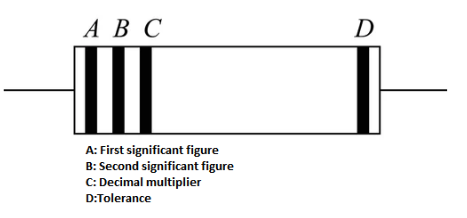
What is the colour code 220 ohm resistor ?
Answer
467.7k+ views
Hint: Learn about resistors. Study about the colour code of resistors that is used to mark a resistor in the electric industry. We know that an electronic colour code is used to mark the values or any other ratings in electric components such as resistors, capacitors, inductors, diodes and others.
Formula used:
The colour code for each colour in a carbon resistor is given by,
Black = 0, Brown = 1, Red = 2, Orange = 3, Yellow = 4, Green = 5, Blue = 6, Violet = 7, Grey = 8 and White = 9
Complete step by step answer:
The colour code that is used to identify any carbon resistor is coded by mainly three colours.The first colour that is marked in a carbon resistor from the left denotes the first significant figure of the component’s value. The second colour that is marked from the left represents the second significant figure of the component’s value.
The third colour of the colour band represents the decimal multiplier. Meaning the number of zeros that will be written after the first two figures of the value. The fourth colour represents a tolerance value ranging from 5,10 and 20 percent. The gold colour signifies a tolerance of 5 percent, the silver colour represents a tolerance of 10 percent and no colour in the fourth colour means a tolerance of 20 percent.
Now, the colour code of different colours is given as follows.
Black= 0, Brown = 1, Red = 2, Orange = 3, Yellow = 4, Green = 5, Blue = 6, Violet = 7, Grey = 8 and White = 9

So, we can see that the number 2 signifies the colour red and 1 signifies the colour brown
Now, 220 ohm resistance has two significant figures 2 and 2 and the number of zeros after the significant figures is one.
Hence the colour code of 220 ohm resistor will be – red, red and brown.
Note: To find the value of any practical resistor that we use it is important to remember the colour code of carbon resistors. It can be easily remembered by remembering the first letter of the sequence that is BBROY GBV GW.
Formula used:
The colour code for each colour in a carbon resistor is given by,
Black = 0, Brown = 1, Red = 2, Orange = 3, Yellow = 4, Green = 5, Blue = 6, Violet = 7, Grey = 8 and White = 9
Complete step by step answer:
The colour code that is used to identify any carbon resistor is coded by mainly three colours.The first colour that is marked in a carbon resistor from the left denotes the first significant figure of the component’s value. The second colour that is marked from the left represents the second significant figure of the component’s value.
The third colour of the colour band represents the decimal multiplier. Meaning the number of zeros that will be written after the first two figures of the value. The fourth colour represents a tolerance value ranging from 5,10 and 20 percent. The gold colour signifies a tolerance of 5 percent, the silver colour represents a tolerance of 10 percent and no colour in the fourth colour means a tolerance of 20 percent.
Now, the colour code of different colours is given as follows.
Black= 0, Brown = 1, Red = 2, Orange = 3, Yellow = 4, Green = 5, Blue = 6, Violet = 7, Grey = 8 and White = 9

So, we can see that the number 2 signifies the colour red and 1 signifies the colour brown
Now, 220 ohm resistance has two significant figures 2 and 2 and the number of zeros after the significant figures is one.
Hence the colour code of 220 ohm resistor will be – red, red and brown.
Note: To find the value of any practical resistor that we use it is important to remember the colour code of carbon resistors. It can be easily remembered by remembering the first letter of the sequence that is BBROY GBV GW.
Recently Updated Pages
Master Class 12 Business Studies: Engaging Questions & Answers for Success

Master Class 12 Biology: Engaging Questions & Answers for Success

Master Class 12 Physics: Engaging Questions & Answers for Success

Class 12 Question and Answer - Your Ultimate Solutions Guide

Master Class 12 English: Engaging Questions & Answers for Success

Master Class 12 Economics: Engaging Questions & Answers for Success

Trending doubts
Which are the Top 10 Largest Countries of the World?

What is transplantation in agriculture class 12 biology CBSE

Differentiate between homogeneous and heterogeneous class 12 chemistry CBSE

Why is the cell called the structural and functional class 12 biology CBSE

Who discovered the cell and how class 12 biology CBSE

What is the Full Form of PVC, PET, HDPE, LDPE, PP and PS ?




